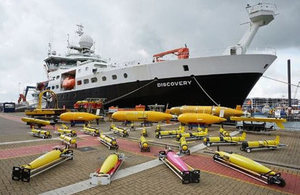DISCOVERY - UK’s state-of-the-art research vessel in Punta Arenas, Chile
The British ship RRS Discovery, a multidisciplinary ship specifically designed for the challenges of 21st century oceanography, is in Punta Arenas, Chile, showcasing some of the best of British marine science and innovation.

RRS Discovery with Marine Autonomous Systems.
The RRS Discovery arrived in Punta Arenas in advance of her next research expedition, to undertake seismic survey and piston coring operations in the eastern Falkland Plateau region of the Subantarctic Southwest Atlantic Ocean. This expedition is part of the UK-International Ocean Discovery Program, an international marine research collaboration dedicated to advancing scientific understanding of the Earth through drilling, coring, and monitoring the subseafloor.
While in port, on 9 January, Her Majesty’s Ambassador, Fiona Clouder, ship’s Captain, Antonio Gatti and other representatives from the National Oceanography Centre, the British Antarctic Survey and the University of Southampton, are hosting a reception for representatives from local government and the marine sector in Chile. Guests will tour the ship and have opportunity to network about science links between Chile and UK scientists.
On 10 January, Her Majesty’s Ambassador, Fiona Clouder, ship’s Captain, Antonio Gatti and ship’s crew are hosting a visit by students from the University of Magallanes, to give the young scientists of the future, the chance to learn about how research is conducted at sea
The RRS Discovery was designed by A.S. Skipsteknisk and was delivered to the National Oceanography Centre on 8 July 2013. Fitted with the most up-to-date and high-tech instruments and equipment, it is ideal for oceanic exploration.
The National Oceanography Centre (NOC) is the United Kingdom’s centre of excellence for oceanographic sciences and one of the top 3 oceanographic institutions in the world. It is renowned for its ability to invent cutting-edge technology and to carry out world leading science on a global scale.
With the ability to travel to remote and extreme oceanic environments, RRS Discovery is highly sophisticated and has the ability to operate in high sea states. The ship comes with sub-bottom profiling and multi-beam equipment for mapping the seabed, while her dynamic positioning capability means that Remotely Operated Vehicles can be used. Her wide range of cranes and over-side gantries, with associated winches and wires, will allow many different types of equipment to be deployed from the ship.
Life on board a research ship (RRS Discovery)
Life on board a research ship (RRS Discovery)
Centenary of the Discovery Committee
The UK has the longest track record of undertaking marine scientific research in the world and is also a pioneer in marine science and exploration. As part of this legacy, this year we celebrate the centenary of the Discovery Committee, which was created by the UK government to carry out scientific investigations in the world’s southern regions.
The RRS Discovery is the fourth research vessel with this name. The first Discovery ship was designed for Antarctic research and was launched as a Royal Research Ship (RRS) in 1901. Its first mission was the British National Antarctic Expedition, carrying Robert Falcon Scott and Ernest Shackleton on their first, successful journey to the Antarctic, known as the Discovery Expedition.
British scientists in Punta Arenas
Four world-class British scientists are also in Punta Arenas, prior to a visit to Rothera station in Antarctica. They are:
Dr Rob Larter, British Antarctic Survey
Robert Larter is a Marine geophysicist who has been working at the British Antarctic Survey since 1987. His main research focus since 2004 has been on late Quaternary ice sheet history, glacial geomorphology and glacial/glacial-marine processes. He has also been involved in research on tectonic and palaeo-environmental history of Antarctica and the Southern Ocean through the Cenozoic era. He is an expert in the processing and interpretation of seismic reflection, marine magnetic, swath bathymetry and sidescan sonar data. Scope of theoretical knowledge and coding experience includes forward and inverse seismic modelling and tectonic plate fitting/rotation calculations.
Kevin Forshaw, Associate Director, Innovation and Enterprise, National Oceanography Centre
Kevin has been engaged in supporting the Marine and Maritime sector for over 15 years, acting as the interface between universities, research organisations and industry. Kevin has established numerous collaborative research projects focused on vessel efficiency, and now increasingly Marine Autonomous Systems.
Dr Steven Bohaty, Associate Professor in Stratigraphy and Palaeoceanography, University of Southampton
Dr Steven Bohaty’s is an Associate Professor within Ocean and Earth Science, National Oceanography Centre Southampton at the University of Southampton. He is a lecturer at the Southampton Marine and Maritime Institute, University of Southampton (2013-2016), and postdoctoral researcher at the University of Southampton.
Dr Claus-Dieter Hillenbrand, British Antarctic Survey
Dr Hillenbrand is a marine geologist and sedimentologist, who is interested in glacial and glaciomarine depositional processes and ice-sheet reconstructions. His research during the last 20 years was the sedimentological study of Late Miocene to Holocene glacial and marine sediments from the West Antarctic continental shelf, slope and rise. Dr Hillenbrand has considerable expertise in analysing, dating, and interpreting marine sediment cores and participated in fourteen marine geological and geophysical cruises to Antarctica and the Southern Ocean on RRS James Clark Ross, RV Polarstern and RV Sonne.
Further information
For more information about this visit, contact Marianne Becker, Head of Communications, British Embassy, Santiago.
For more information about the events and activities of the British Embassy in Santiago, follow us on: